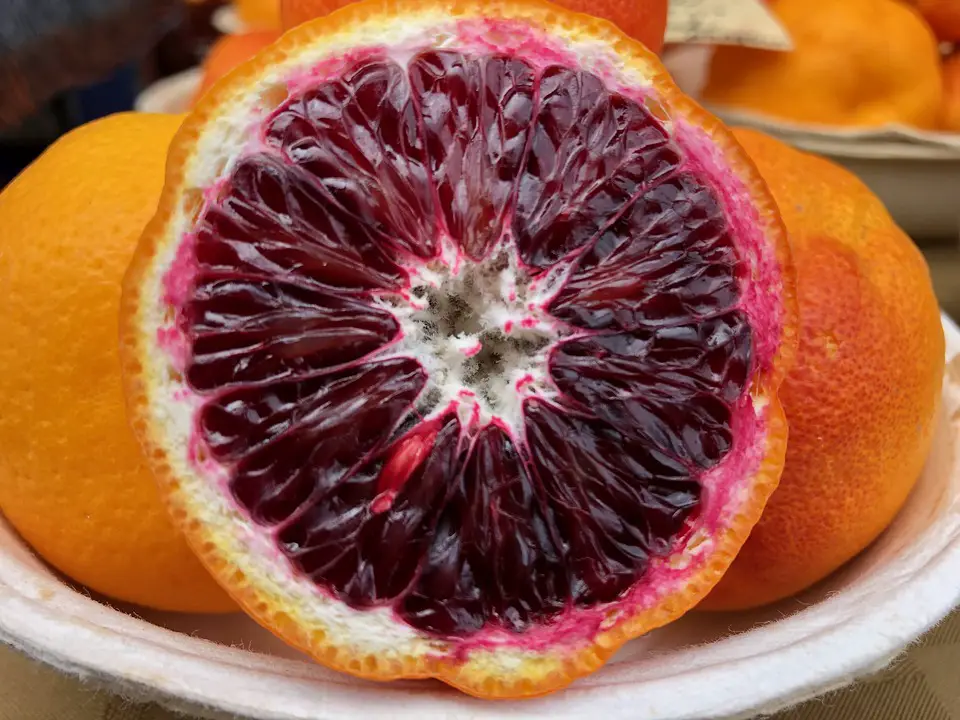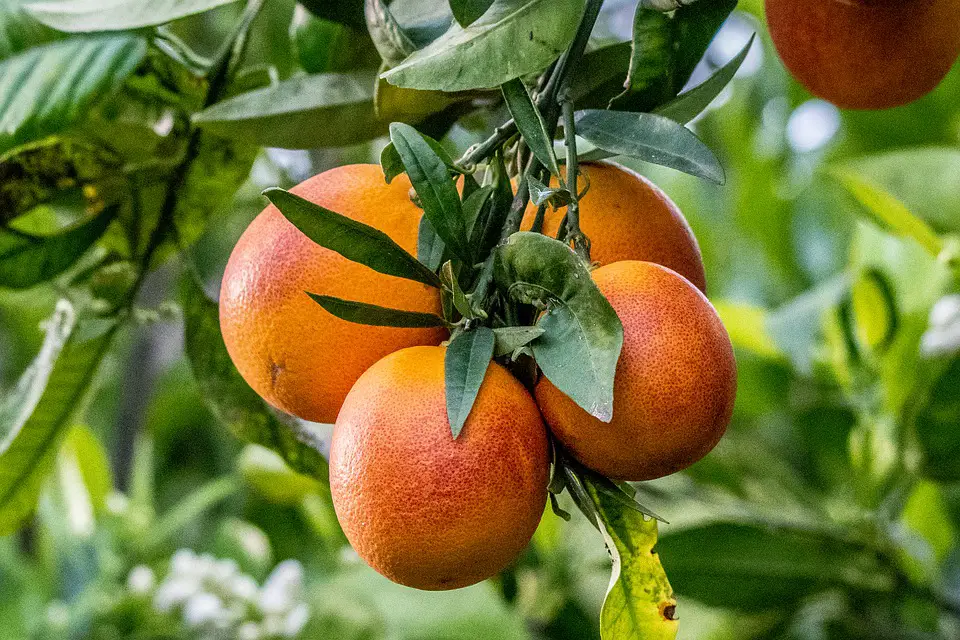Every gardener grows small fruit plants in their garden or in a container, whichever they prefer. But at the same time, they also want a plant, which is unique, and attractive and that can provide them with the best fruit throughout the season. In this article, we are going to learn about one such fruit plant. You will learn here about how to grow blood oranges from seeds.
Blood Orange Tree

Blood oranges are from the family of oranges. These are almost the same as the other families of oranges like round shapes, orange, or mixed red and orange colors. These are preferred at the commercial level as well as domestic plants.
As mentioned earlier, these are like the other citrus fruits found on the planet. But when these are cut the flesh inside is the real deal. The flesh inside the fruit is blood red, that’s why it is known as blood orange. These are usually grown in Asia, but now it is grown all over the world.
This blessing of mother nature has been cultivated for centuries for juices, pulp, sweats, and culinary mixtures and creations. These are also used with many items in the bakery and drinks. It is preferred as it looks good, and also because of the refreshing taste.
It has a sweet smell, and this fruit is usually sweeter than the other types of citrus fruits. Also, the smell of its leaves is very attractive and refreshing. The fruit of the blood orange has few seeds inside and it is easy to peel if compared to other types of citrus fruits.
How do you grow blood oranges?
These plants can be grown easily in containers or pots. As we all know all citrus varieties need the sun and good soil to nurture. These are good with the mild winters but can’t stand the frost season. So, if it is grown outdoors, we have to cover it or move it to shade, this becomes a lot easier if they are grown in containers.
How can I make my orange tree grow faster?
Oranges are grown from seeds, but the result of fruit is taken by the process of grafting. Because grafting takes less time in fruit development, grafting develops resistance to diseases, and it also helps in developing new tastes. Otherwise, the blood orange fruit can take 8 to 13 years to produce fruit.
So, most of the time the oranges, and especially blood oranges are taken to the gardens after the process of grafting. After the grafting is done people take care of them and keep them according to the instructions.
Until or unless you are a passionate and joyful gardener, who wants to try and learn a lot, you should not go for the method of growing blood oranges from the seeds. Because it will take a lot of time and energy to bear fruit. But here we will discuss it from the scratch.
Growing Blood Oranges from Seeds
As mentioned earlier, you would like to get a plant of blood orange from a nursery if you want to get fruit early like other normal plants. Otherwise, you have to follow the following steps.
Getting and Cleaning the Seeds
Start by picking up the seeds from a nearby trusted nursery or any online plant store. Once you get the seeds, you can move to the next steps. Here is another way to start the blood oranges and that is to get the seeds directly from the fruit.
Blood Orange Seeds
Do blood oranges have seeds?
Yes, this orange has seeds. Cut the blood orange in half and you can use a knife or spoon to get the seeds from it. Then clean these seeds with a tea cloth preferably. First, wash all the seeds there which are present with enough water. Then use a tea cloth to wipe and dry them.
Selecting, Soaking, Sowing, and Germination
Select the seeds which are healthy, not broken, and seem fit to sow. Then take a bowl of water and soak all the seeds which you want to sow. Soak for 24 hours because it gives a good chance of germination. After soaking the seeds, put them into a towel or thick tissue paper to soak.
Get the soaked seeds and sow them in the soil, which is prepared for this purpose. Bury the seeds up to 3 to 4 inches. Keep the pot or choose the place where seeds are sown that should get the bright sunlight. When germination starts, keep them watering and add mild fertilizers to the soil.
Transplanting, Placing, and Caring
Now we need to transplant the plants into the pots or garden to grow more. When leaves arrive, it’s time to transplant. Prepare the soil or pot before transplanting. It should have a good drainage system. So, after you have prepared them, transplant the plant to them. Dig 2 inches deep and 2-inch wide holes for every single plant.
Place the plant there and gently fill the hole with soil and press it. Make sure that there is enough moisture in the soil. Otherwise, water it in advance. Put the pot in a sunny location. Water the plant regularly as the orange plant needs water.
Fertilize the growing tree. Especially in the spring and the early winter. Keep the schedule for fertilizers. After a year when the plant is about 12 to 15 inches, you will need a bigger pot. You will have to follow the same instructions to transplant the plant from one pot to another bigger pot.
Grafting of the Blood Oranges
Grafting is a very unique ability. It needs care to be done properly. When the plant is grown enough then you need to graft it to get the desired fruit. Blood oranges are the same. You need to get 8 to 10 buds from another blood-orange tree. Then select a place where to graft. It should not be above 8 to 10 inches from the ground.
Make sure the buds are at least one year old. Make a 1-inch cut in the bark and wood of the blood orange. Place the biggest bud in it and cover it with bark. Then cover all the surrounding area including the bud with budding tape completely. This will keep the minimum required moisture.
Remove the tape after three to four weeks. If you see the green-based buds, this means that the plant has established graft, whereas the others have rotted. Repeat the same procedure with all the buds. Your grafting is done.
Blood Orange Tree Care
Care needs to be taken in terms of garden resources. In the case of blood oranges, it is necessary. Because not only do we have to take the fruit, but also, we have done a lot in the process to get the blood orange plant, then convert it into a tree.
Well in terms of sunlight, all citrus fruits need bright sunlight to grow and blood oranges are no exception. In the winter you need to keep the blood orange in a bright place. When the plant is grown in indoor settings, move the plant to a location where there is bright sunlight.
Harsh winter conditions can harm this plant. While in that season, cover the plant with blankets or straw and cover the base with a thick layer of mulch.
Fertilizing and watering

Fertilize the plant three or four times a year. Blood oranges require iron, zinc, and manganese. You can use the best organic fertilizers, or you can use chemical fertilizers as well. Also, water the plant of blood oranges to keep the moisture to the required level. Avoid over-watering.
Pale leaves might indicate overwatering and low levels of fertilizers. When there is fruit season water the plant most. Because the more you water the plants you will get more and more juicy blood oranges. Make sure the drainage system in the soil is working well.
Pruning
Pruning is very effective in the case of blood oranges. It is suggested that the blood oranges plants reduce their height. Also, it is important to understand that it will bloom a lot because of pruning. You have to prune it to make it fit in your gardening area or the container in which it is sown or grown
If the blood orange is domesticated and growing at the normal pace, re-pot it after 3 to 4 years and cut the roots by one-third ratio. Also, add new soil to the pot. This will keep blood orange happy and healthy for the coming years.
Pests, Diseases, and Remedies of Blood Orange Tree
There are a lot of pests and diseases according to the climate, nature, and area of the blood orange where it is grown. Some pests are categorized according to the type of attack. Some pests or diseases can attack wood, and leaves or some can attack the fruit as well.
To keep the blood orange away from pests and diseases you have to constantly watch it. Because some pests and diseases might be season-specific. Kindly note that you have to observe the symptoms and then go to the nearby horticulturist to get recommendations for remedies.
Usually, it doesn’t get affected by a lot of pests and diseases, but taking care is due because it takes a lot to have blood oranges in a room.
So, the blood oranges are so attractive and quite fun to grow while having sweet and beautiful fruit. We can try it because it will increase our knowledge and experience of gardening as well as it will be a great fresh addition to your garden.
ALSO, READ
HOW TO GROW RED YUCCA FROM SEED
References
https://www.gardeningknowhow.com/edible/fruits/oranges/blood-orange-tree-care.htm
https://homeguides.sfgate.com/plant-blood-oranges-46656.html

